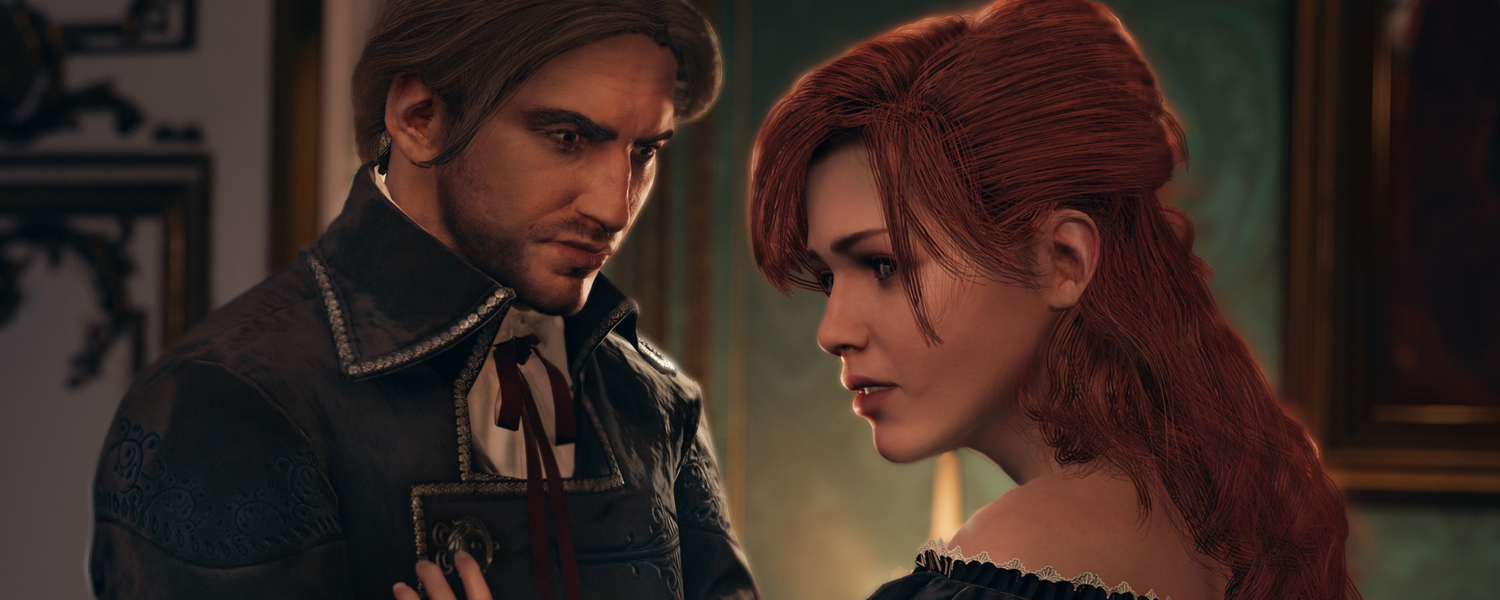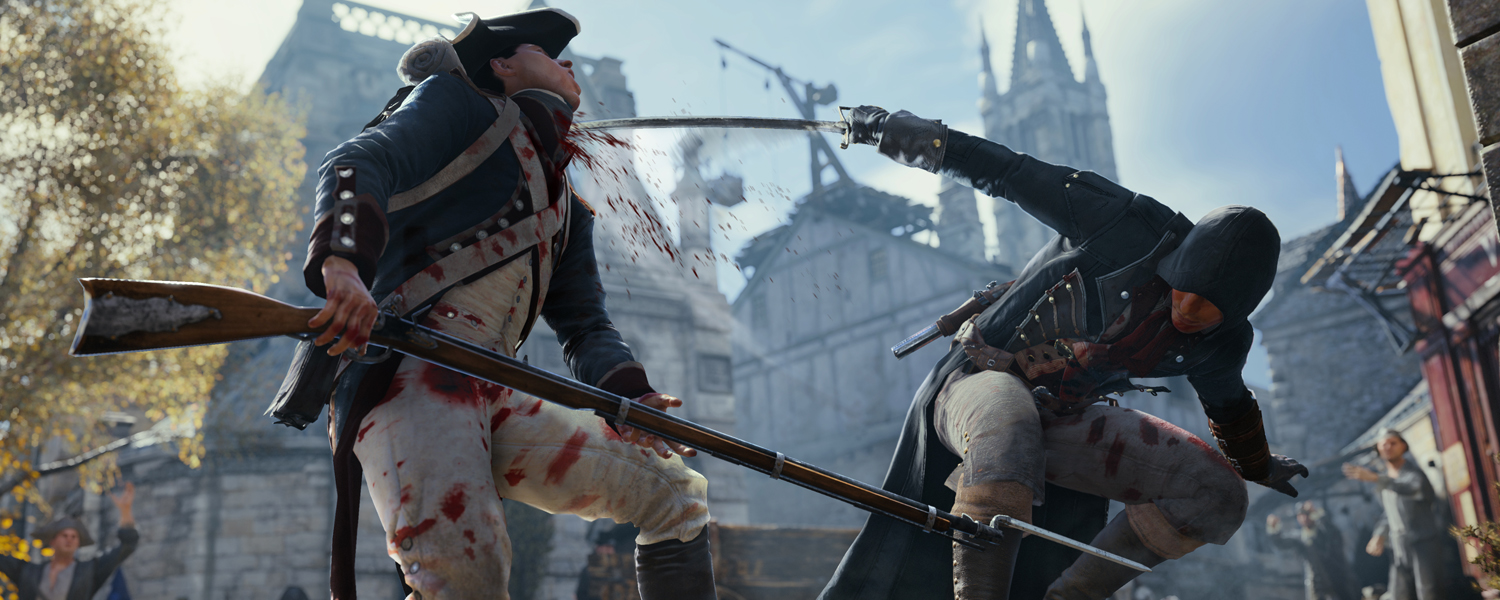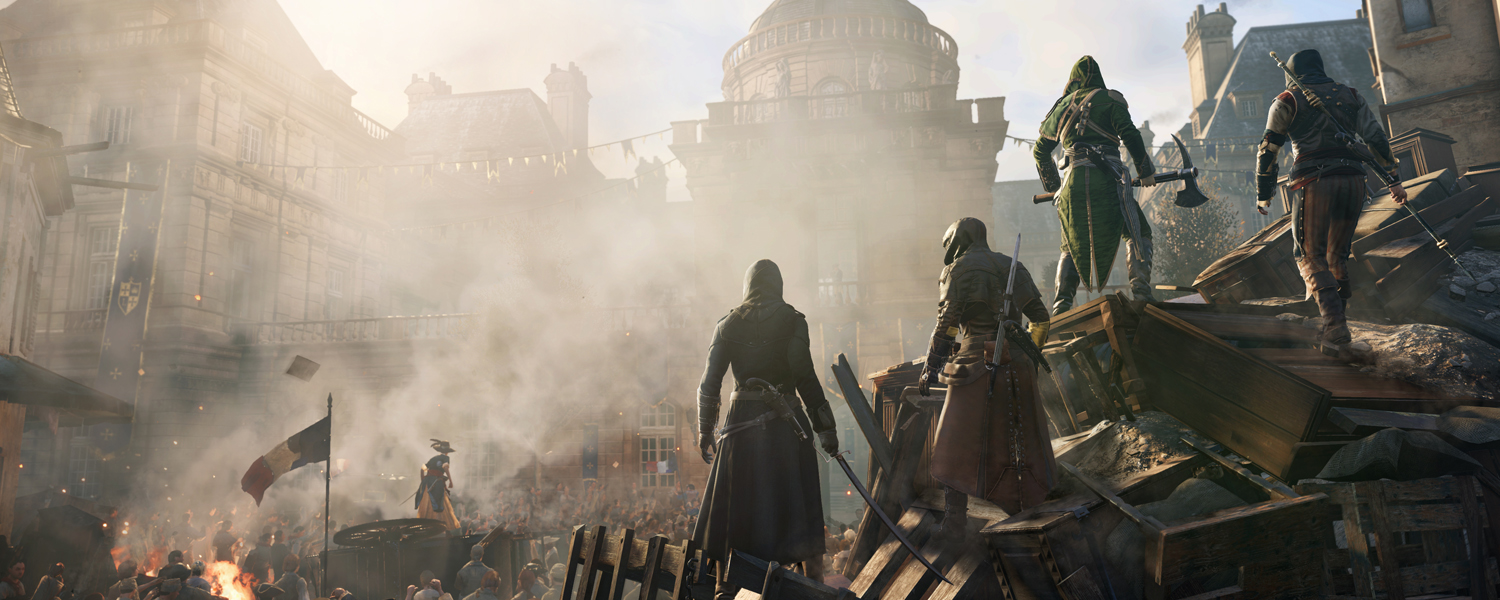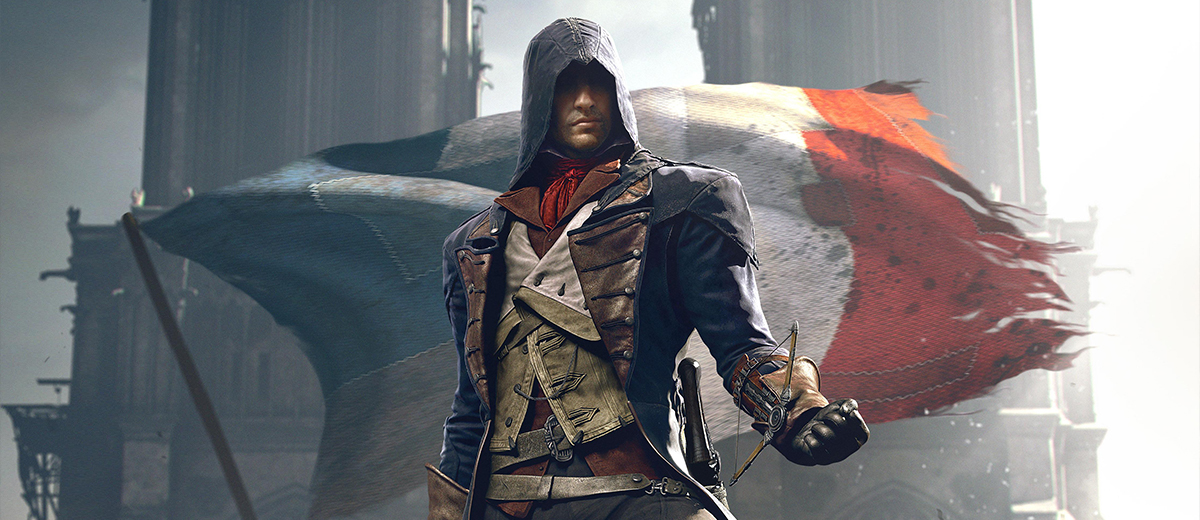
 Assassin’s Creed Unity’s storyline takes place during the French Revolution, with its main plot spanning multiple years throughout its course. Our main protagonist Arno is hit by tragedy at a young age, and after being brought up by a Templar surrogate-father Arno soon finds himself in the middle of a conflict that has been raging for hundreds of years. After being framed in connection to a crime he didn’t commit Arno is approached by the Assassin’s Brotherhood, who recruit him and train him in the arts of the Assassin’s. Divided between following the creed and seeking redemption, Arno tries to seek out the individuals responsible for his tragedies, but soon he finds himself entangled in a plot that is much bigger than himself.
Assassin’s Creed Unity’s storyline takes place during the French Revolution, with its main plot spanning multiple years throughout its course. Our main protagonist Arno is hit by tragedy at a young age, and after being brought up by a Templar surrogate-father Arno soon finds himself in the middle of a conflict that has been raging for hundreds of years. After being framed in connection to a crime he didn’t commit Arno is approached by the Assassin’s Brotherhood, who recruit him and train him in the arts of the Assassin’s. Divided between following the creed and seeking redemption, Arno tries to seek out the individuals responsible for his tragedies, but soon he finds himself entangled in a plot that is much bigger than himself.
It’s implied narrative seems incredibly interesting at first glance, but a few chapters into the story players may find that the contents of its narrative aren’t as intriguing as one may expect. Arno’s story starts off with quite an interesting premise, and the conflicts and events early on in the story seem quite interesting. The son of an Assassin brought up by a Templar with the love of his life being one of them, and whilst these ideas sound great, Unity never seems to properly delve into the depths of these concepts.

At first glance Arno seems similar to Ezio as a character, and whilst Arno isn’t exactly unlikeable, his story doesn’t give the player much to go on from. His initial conflict at the start of the narrative is a great foundation for a conflicted and relatable character, but the subsequent chapters in his story lack a sense of depth that’s able to keep players interested in him as a protagonist.
Many of the characters suffer from not a lack of characterisation, but more the lack of actual screen time and development. Many returning characters throughout the game are lost to the player by the fact that there simply isn’t much to their presentation, and from time to time you may not remember certain characters due to their lack of development. Due to the nature of the game and story this is an understandable fault, but none the less it is one worth of note.
Once again the storyline places the conflict between the Assassins and Templars in the spotlight, and the results suggest that the franchise may need to change up the dynamic a bit in order to keep things fresh and interesting. Its main antagonist and overall evens seem rather stale due to the fact that players may feel like they’ve seen and experienced it so far, and the standard Assassin vs Templar formula seems to have lost its touch when it comes to providing an interesting conflict and narrative.

In the final hours of Assassin’s Creed Unity the narrative did seem to speed up things a bit, but the finale of the game seemed quite hollow, and in the end Ubisoft didn’t seem to make the most out of its setting on a narrative-perspective. Unity’s storyline holds itself together throughout the campaign, but it’s one of the lesser narratives that the franchise has given us so far. Unity has many interesting concepts, but it never takes enough time and effort to properly develop them.
On a more positive note Ubisoft finally seems to have given the modern day sequences a boot, and whilst there is still modern day material present, it’s limited to small cutscenes and sequences that link the Parisian setting to its digital counterparts, which create some interesting gameplay opportunities rather than cutting up the flow of the game.
 On a visual front Assassin’s Creed Unity is without a doubt one of the biggest leaps within an existing franchise that we’ve seen so far this generation. From the amazing visuals of Paris to the detailed character models, Unity offers one of the most immersive experiences visually that we’ve seen so far in this franchise. Whilst Unity is a technically problematic title, it’s still an impressive title none the less.
On a visual front Assassin’s Creed Unity is without a doubt one of the biggest leaps within an existing franchise that we’ve seen so far this generation. From the amazing visuals of Paris to the detailed character models, Unity offers one of the most immersive experiences visually that we’ve seen so far in this franchise. Whilst Unity is a technically problematic title, it’s still an impressive title none the less.
The most noteworthy leap is the setting. Set in Paris during the French Revolution the city is the most detailed world that Ubisoft has created so far. The biggest change that some won’t even notice visually is the fact that Ubisoft has scaled the structures on a 1 on scale, meaning that all structures are the exact same proportions that they would be in real life, which has positive consequences for both the visuals and gameplay. Textures and draw distances in general seem excellent, but there are certain issues that may take the game down a notch at certain points.
LOD issues and pop-in seem vary apparent at times, and whilst the game in general looks amazing, these problematic moments create a temporary technical downfall that makes the title look rather rough at times, hinting that the game could’ve benefitted from a few extra months of development to fine-tune the game world. Draw distances have improved significantly, but the earlier mentioned LOD issues make the game look a bit rough from certain perspectives. Textures are generally of high quality, but in certain scenarios some textures can have a muddy look to them, and sometimes it may take a second or two for some of them to load properly.
 Character models have seen significant improvements, and especially during cutscenes the improvements in details and textures seem very apparent. The detail on Arno especially is staggering at times when you look at his gear and facial features, which seem very well-crafted. Hair also seems to have improved in most cases, though at the edges are incredibly rough looking, which can stand out a bit from otherwise impressive character models. NPC character models tend to vary from ok to impressive, but there are some weird glitches when it comes to placing them in the game world. From time to time you’ll see NPC’s switching models in front of you, and in more extreme cases they’ll pop up in locations they clearly weren’t meant to. Variations between NPC character models seem sufficient, though sometimes the only difference is that they’ll be wearing a different set of clothes and/or gear to switch things up. Admittedly you won’t be paying much attention to most of their facial features, and it’ll be more bothersome if you’re actually paying a lot of attention to it.
Character models have seen significant improvements, and especially during cutscenes the improvements in details and textures seem very apparent. The detail on Arno especially is staggering at times when you look at his gear and facial features, which seem very well-crafted. Hair also seems to have improved in most cases, though at the edges are incredibly rough looking, which can stand out a bit from otherwise impressive character models. NPC character models tend to vary from ok to impressive, but there are some weird glitches when it comes to placing them in the game world. From time to time you’ll see NPC’s switching models in front of you, and in more extreme cases they’ll pop up in locations they clearly weren’t meant to. Variations between NPC character models seem sufficient, though sometimes the only difference is that they’ll be wearing a different set of clothes and/or gear to switch things up. Admittedly you won’t be paying much attention to most of their facial features, and it’ll be more bothersome if you’re actually paying a lot of attention to it.
Unity on consoles is presented at a resolution of 900p with an advertised frame rate of 30 frames per second. The latter is never achieved in the product at its current form however, and the game continuously drops to as low as 19 frames per second. Certain situations involving a high amount of NPC’s and/or advanced lighting conditions seem to be the most problematic moments for the engine, though I did get used to the framerate a few hours into the game. The game is never unplayable due to these drops, but it can be quite hindering during combat and precise traversal throughout the city. These issues may be (partially) fixed in an update, but in its current state the game tends to be unstable in many occasions.
 Surprisingly the biggest improvements of the game that I found during my sessions were the new animations, which seemed jawdropping at points. Traversal, combat and even subtle movements seem incredibly lifelike, and transitions between individual animation sequences seem more fluid than the franchise has ever seen, which has been problematic in the past of the franchise. The system isn’t fool-proof however, and from time to time you’ll encounter some interesting glitches that range from annoying to hilarious at times. NPC animations are of the same quality, and their movements/reactions are very convincing, though paired with technical issues and glitches some hilarious scenarios may follow.
Surprisingly the biggest improvements of the game that I found during my sessions were the new animations, which seemed jawdropping at points. Traversal, combat and even subtle movements seem incredibly lifelike, and transitions between individual animation sequences seem more fluid than the franchise has ever seen, which has been problematic in the past of the franchise. The system isn’t fool-proof however, and from time to time you’ll encounter some interesting glitches that range from annoying to hilarious at times. NPC animations are of the same quality, and their movements/reactions are very convincing, though paired with technical issues and glitches some hilarious scenarios may follow.
Unity’s user interface isn’t all that different from its predecessors, but it gets the job done for the most part. At times the HUD can be a bit distracting when it comes to viewing the visuals, and when you’re not in combat keeping track of your health and /or your weapons, you’ll most likely want to turn it off to take it all of the visuals in, which makes the game feel a lot more immersive.
 In many aspects Assassin’s Creed Unity is a return to the same basic formula that the first few games applied to their mechanics. Rather than having a huge world in which the player travels from city to city the game focusses on a singular large-scaled city in which the entire narrative takes place. with the earlier mentioned realistic scaling the player world still feels massive, despite taking place in a single city.
In many aspects Assassin’s Creed Unity is a return to the same basic formula that the first few games applied to their mechanics. Rather than having a huge world in which the player travels from city to city the game focusses on a singular large-scaled city in which the entire narrative takes place. with the earlier mentioned realistic scaling the player world still feels massive, despite taking place in a single city.
Traversal throughout the world is much more advanced, and whilst travelling throughout the city you’ll have dedicated buttons for parkour in both vertical directions, making it much easier to vary elevation along the way, resulting in the loss of accidentally jumping to your death from high structures by making minuscule mistakes. The pace of traversal has been steadily improved, and dodging obstacles and moving through windows is done without compromising the pace of gameplay. At times Arno will grab on to too many objects though, and there are situations where he’ll accidentally grab onto the wrong object and interrupt your otherwise perfect run, which can be quite frustrating during some missions.
 The main mission structure of Unity is similar to the previous titles, but with a few twists that make them a bit more interesting for players. Assassinations can be handled from multiple angled, and in front of those missions Arno will first scan the area, after which the player is provided multiple options to enter the area. You’ll be able to go in guns-blazing (or sword, well you get the point) or using a stealthy approach, which is a lot easier than it use to be as Unity is the first game in the franchise to introduce a proper stealth system for players.
The main mission structure of Unity is similar to the previous titles, but with a few twists that make them a bit more interesting for players. Assassinations can be handled from multiple angled, and in front of those missions Arno will first scan the area, after which the player is provided multiple options to enter the area. You’ll be able to go in guns-blazing (or sword, well you get the point) or using a stealthy approach, which is a lot easier than it use to be as Unity is the first game in the franchise to introduce a proper stealth system for players.
Unity relies a lot on its newly implanted stealth-system, and it has its ups and downs when it comes to effectiveness. The most welcome introduction is the ability to crouch and use cover, which makes stealthy entrances into enemy territory a lot more precise. The cover system isn’t perfect however, and switching between covers can be quite a hassle when the game has seemingly stuck you to the other. Another change to stealth is the fact that you can no longer whistle to attract enemies, and instead you’ll have to use firecrackers to attract them. Attracting enemies this way still works, but the change seems rather counter-productive since the game is looking to put a bigger emphasis on stealth elements.
Combat has been refined as well, and returning players will have to adjust their timing to adapt to the new, less-forgiving system that Unity uses. Parrying for instance seems a lot less overpowered than it use to be due to the shorter time-frames for these actions and the fact that it’s simply not a viable option against some enemies and weapons. In certain cases you’ll need to adapt a different strategy depending on the enemy, and moving against large groups of enemies simply isn’t the best idea. Along with this health has also taken a turn back in the direction of earlier titles, and you’ll need to buy and/or find medicine to replenish your health rather than waiting for it to replenish by itself.
 Unity provides players with a lot more variety in its side-missions, and a lot of them are actually quite imaginative. Murder-mysteries for example are some of the strongest non-centric gameplay elements that the franchise has provided in a long time, and figuring out most of them is actually fun, rather than feeling like a chore to complete. Nostradamus Enigmas will also keep the players busy for quite a while, as they require quite some cerebral activity from the player whilst figuring out these sometimes maddening mysteries. The only side-missions that truly felt like a chore during my sessions were the Helix Rift sequences, which felt like fluffing in order to provide more content.
Unity provides players with a lot more variety in its side-missions, and a lot of them are actually quite imaginative. Murder-mysteries for example are some of the strongest non-centric gameplay elements that the franchise has provided in a long time, and figuring out most of them is actually fun, rather than feeling like a chore to complete. Nostradamus Enigmas will also keep the players busy for quite a while, as they require quite some cerebral activity from the player whilst figuring out these sometimes maddening mysteries. The only side-missions that truly felt like a chore during my sessions were the Helix Rift sequences, which felt like fluffing in order to provide more content.
The biggest change in gameplay in the game is an optional one, but co-op is one of the strongest additions the franchise has had on a multiplayer front in a long time. Providing players with both regular missions and co-operative heists there is a good amount of content to explore together. Navigating missions often requires communication between players in order to be played through properly, and it’ll be a good idea to strategise you’re approach when heading into heist missions. Along with this you’ll also be able to explore the open world together. These missions can be quite a lot of fun, though currently getting into missions can be quite a hassle as the game is currently riddled with online issues, which seem to be affecting multiple portions of the game.



